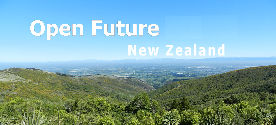
Open Future New Zealand
This DEFAULT display is for a Tablet Screen (Gold Border). Change now to link to this same page with your preferred screen size.
The Climate is Changing
Climate Collapse
In 1987, the World Commission on Environment and Development (WCED), which had been set up in 1983, published a report entitled "Our common future" (240 page pdf). The document came to be known as the "Brundtland Report" after the Commission's chairwoman, Gro Harlem Brundtland. It developed guiding principles for sustainable development as it is generally understood today.
We have tried to:
Tell people about the problem. The first climate conference was the UN Framework Convention of Climate Change in 1992.
We set up an expert panel the IPCC to study and report on the issue.
197 countries signed the Paris Accord in 2015-2016, promising to reduce GHG emissions. Today we are still feeding excess CO₂, CHI₄ and N₂O into the atmosphere.
These efforts have failed to get any effective reduction in GHG's.
Not a single country in the world has reduced their emissions more than 1%, when the target for every developed economy is something like 7% every year.
Glaciers and mountain snowfield's are in retreat.
Sea-ice is declining significantly.
Ocean heat is at record levels.
In the lifetime of today's children, given business as usual, the baseline temperature of the Earth is predicted to rise 3 to 4 degrees centigrade.
Wet Bulb Temperature of 37 Degrees Celsius
Current predictions of mean temperature rises of 3º or 4º Celsius, may not seem extreme. Here's the rub. When high temperature and high humidity combine, people can't use sweating to cool themselves. You can die in a few hours.
The CSIRO and Bureau of Meteorology estimate the average number of days over 35ºC in Western Sydney could increase by up to five times by 2090.
Put another way, Western Sydney will have an extra month of days over 35ºC by 2090.
Mattheos Santamouris, a professor at the University of New South Wales, in Sydney, and a globally recognised expert on building cooler cities, believes that without action to help residents adapt to hotter summers, "many places" in Western Sydney will be abandoned over the next 20 to 30 years.
There is a threshold for this, a wet-bulb temperature of 37ºCelsius. (Anything above 35 degrees Celsius, endangers your health.)
In this situation working outdoors is almost impossible. Living and working indoors is only possible if the air conditioning is working. In very hot conditions maintenance of the electrical grid is problematic, and remember that line repair (outdoor work) may not be possible.
Think about all the coastal tropical regions of the world. They may become places were human habitation is difficult or impossible. Certainly, the huge populations that live there now will need to relocate.
That takes no account of how other plants and animals will cope. We depend on them for our survival too.
Covid-19 has shown us that it's possible to reduce economic activity and our carbon footprint, if we have to. There are no sensible numbers yet on the climate impact of that, but it's small. But to contain global warming we have to do that and more every year for the next 20 years. People are already demanding a return to business as usual. If we are wise that can never happen. But a return to business must happen, people need to have a livelihood.
